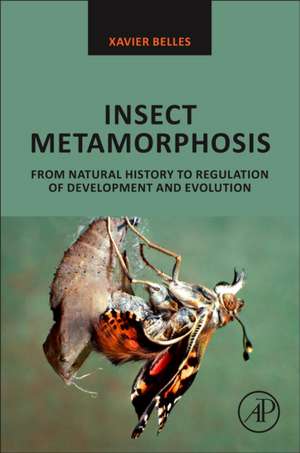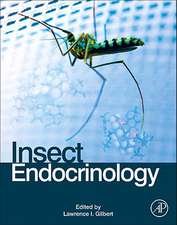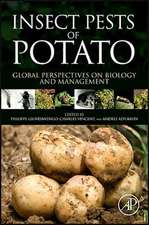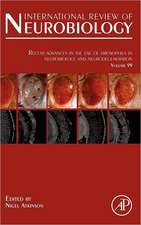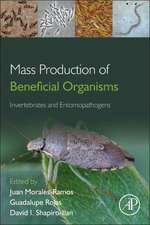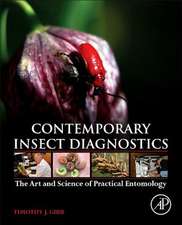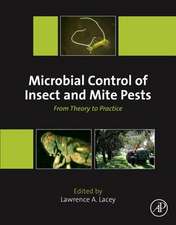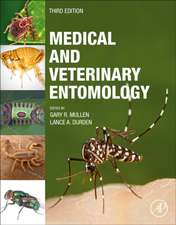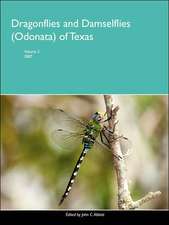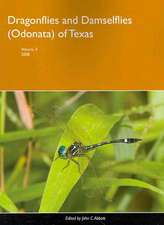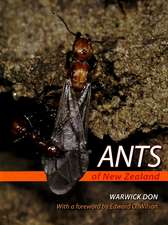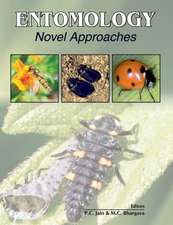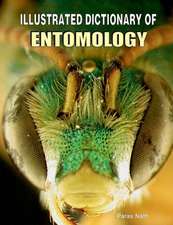Insect Metamorphosis: From Natural History to Regulation of Development and Evolution
Autor Xavier Bellesen Limba Engleză Paperback – 17 mar 2020
Users will find this to be a comprehensive and updated review on insect metamorphosis, covering biological, physiological and molecular facets, with an emphasis on evolutionary aspects.
- Features updated knowledge from the past decade on the mechanisms of action of juvenile hormone, the main doorkeeper of insect metamorphosis
- Aids researchers in entomology or developmental biology dealing with specialized aspects of metamorphosis
- Provides applied entomologists with recently updated data, especially on regulation, to better face the problems of pest control and management
- Gives general evolutionary biologists context on the process of metamorphosis in its larger scope
Preț: 546.33 lei
Preț vechi: 701.34 lei
-22% Nou
Puncte Express: 819
Preț estimativ în valută:
104.54€ • 109.42$ • 87.01£
104.54€ • 109.42$ • 87.01£
Carte tipărită la comandă
Livrare economică 24 martie-07 aprilie
Preluare comenzi: 021 569.72.76
Specificații
ISBN-13: 9780128130209
ISBN-10: 0128130202
Pagini: 304
Dimensiuni: 152 x 229 mm
Greutate: 0.26 kg
Editura: ELSEVIER SCIENCE
ISBN-10: 0128130202
Pagini: 304
Dimensiuni: 152 x 229 mm
Greutate: 0.26 kg
Editura: ELSEVIER SCIENCE
Public țintă
Researchers in insect biology in universities and research institutes; university professors of entomology, developmental biology, and life sciences. Experts in insect pest control in the industry sector as well as in the academic sector. Developmental biologists, especially those working with model insects, like Drosophila, and working in post-embryonic development in non-insect models that experience metamorphosis (amphibians, crustaceans, jellyfishes, etc.). Animal morphologists interested in processes that trigger changes of form. Secondary: Amateur entomologists, insect collectors, members of entomological societies. Teachers (elementary, high school) of natural history.Cuprins
1. The ideas of metamorphosis through time
2. Life cycles and modes of metamorphosis
3. Embryo development and metamorphosis
4. Postembryonic development. Molting
5. Hormones involved in the regulation of metamorphosis
6. Molecular mechanisms of hormonal action
7. The role of microRNAs in the regulation of metamorphosis
8. The origin of hemimetaboly
9. The evolution of metamorphosis
2. Life cycles and modes of metamorphosis
3. Embryo development and metamorphosis
4. Postembryonic development. Molting
5. Hormones involved in the regulation of metamorphosis
6. Molecular mechanisms of hormonal action
7. The role of microRNAs in the regulation of metamorphosis
8. The origin of hemimetaboly
9. The evolution of metamorphosis
Recenzii
"One of the highlights of this volume is the postulation of hypotheses and some potential ways to test them. The epilogue includes the author’s wish list of experiments/data to address knowledge gaps. The book provides a critical compilation of data and inspiration for future endeavors from entomologists, physiologists, and cell and molecular biologists. It is my hope that new techniques and technological advances will allow our ecological and molecular understanding of one of the most fantastic transformations in animal history." --The Quarterly Review of Biology
"Xavier Belles is well-known in the field of international metamorphosis research. Insects are the most diverse group of animals on the planet. The evoluition of it has also made it the most diverse group of organisms. Insect Metamorphosis can provide insect taxonomy, developmental biology, physiology and evolutionary biology research." --Acta Entomologica Sinica
"It is not a text for the whole public, but if you want to understand as deeply as possible the “miracle” of metamorphosis and that the beautiful monarch butterfly that flies thousands of miles is the same individual as the caterpillar that just think about food, this is your book." --Metode
"Insect Metamorphosis begins with a review on the interest that the metamorphosis has awakened throughout the history and scientific attempts to describe and explain it. Xavier Bellés's book is so complete and so multidimensional, that is already and will be for many years a volume essential for all those interested in obtaining a complete view of the evolution, development and function of insects through research on the evolution of their life cycles and, in particular, of metamorphosis." --Bulletin of the Spanish Society of Evolutionary Biology
"As a critical scientist, Belles is well aware that the book answers many important questions on insect metamorphosis, but many are still open, and even more are and will be raised in the coming decades, especially in emergent fields of research, such as epigenetics and comparative genomics. While certainly true, there is one point in which I disagree with Belles, and that is the last sentence of the Epilogue, where he states that “with a bit of luck, we can expect that this book will become outdated pretty soon.” I don't think so, rather, this is a book that I will still want to reread in decades to come." --J Exp Zool (Mol Dev Evol)
"Xavier Belles is well-known in the field of international metamorphosis research. Insects are the most diverse group of animals on the planet. The evoluition of it has also made it the most diverse group of organisms. Insect Metamorphosis can provide insect taxonomy, developmental biology, physiology and evolutionary biology research." --Acta Entomologica Sinica
"It is not a text for the whole public, but if you want to understand as deeply as possible the “miracle” of metamorphosis and that the beautiful monarch butterfly that flies thousands of miles is the same individual as the caterpillar that just think about food, this is your book." --Metode
"Insect Metamorphosis begins with a review on the interest that the metamorphosis has awakened throughout the history and scientific attempts to describe and explain it. Xavier Bellés's book is so complete and so multidimensional, that is already and will be for many years a volume essential for all those interested in obtaining a complete view of the evolution, development and function of insects through research on the evolution of their life cycles and, in particular, of metamorphosis." --Bulletin of the Spanish Society of Evolutionary Biology
"As a critical scientist, Belles is well aware that the book answers many important questions on insect metamorphosis, but many are still open, and even more are and will be raised in the coming decades, especially in emergent fields of research, such as epigenetics and comparative genomics. While certainly true, there is one point in which I disagree with Belles, and that is the last sentence of the Epilogue, where he states that “with a bit of luck, we can expect that this book will become outdated pretty soon.” I don't think so, rather, this is a book that I will still want to reread in decades to come." --J Exp Zool (Mol Dev Evol)
